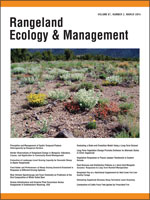A key goal in land management is to prevent ecosystem shifts that affect human well-being. Like other types of sagebrush shrublands, large areas dominated by the common but little-studied mountain silver sagebrush may have shifted to a less productive shrub-dominated alternate state under heavy livestock grazing in the 19th century. The goals of this study are to 1) describe long-term vegetation change in a silver sagebrush mountain park and 2) evaluate evidence that these changes constitute alternate states. We examined vegetation change over the last 57 yr in California Park, Colorado, USA, using monitoring data from 15 permanent transects at six sites. We analyzed change in species composition over time and related it to management and climatic drivers using nonmetric multidimensional scaling. We found that management practices influenced species composition. Spraying herbicides resulted in decreases of sagebrush and a dominant, unpalatable forb (Wyethia amplexicaulis), but sagebrush recovered. Spraying also triggered a temporary increase in native palatable grasses and forbs. Native grasses have since decreased again, coinciding with increases in the cattle stocking rate and elk population. The nonnative pasture grass Phleum pratense has increased to become one of the dominant grasses in 2010. Sagebrush and herbaceous understory dynamics were not consistent with a shrub-dominated alternate state: changes were gradual and not persistent. However, historic Wyethia dominance and the widespread increase in the nonnative grass Phleum were persistent and may represent alternate states. We used these findings to update a state-and-transition model of high-elevation silver sagebrush shrubland dynamics for land management decision making. Our analysis differentiated gradual, nonpersistent changes from potentially irreversible changes, as is necessary for identifying alternate states that are important for land management and ecosystem function. The gradual but persistent increase in the nonnative grass Phleum reinforces others' observations that even incremental changes may lead to irreversible shifts.
How to translate text using browser tools
1 March 2014
Long-Term Vegetation Change Provides Evidence for Alternate States in Silver Sagebrush
Emily Kachergis,
Monique E. Rocca,
Maria E. Fernández-Giménez
ACCESS THE FULL ARTICLE

Rangeland Ecology and Management
Vol. 67 • No. 2
March 2014
Vol. 67 • No. 2
March 2014
Artemisia spp
ecosystem shifts
grazing
herbicide
state-and-transition model
threshold




